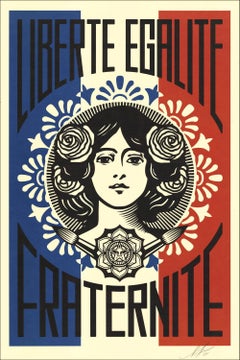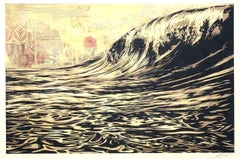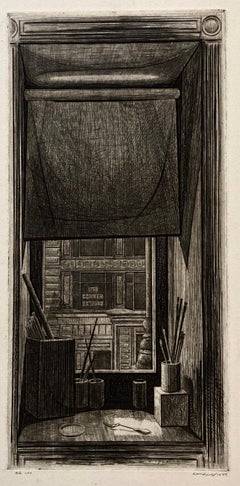Shepard Fairey Prints and Multiples
Expanding on the legacies of artists such as Keith Haring and Andy Warhol, Shepard Fairey’s practice disrupts the distinction between fine and commercial art.
A major artist of the street art movement, Fairey rose to prominence in the early 1990s through the dispersion of prints, posters, stickers and murals, related to his Obey Giant campaign, which yielded an international cultural phenomenon. Fairey’s iconic poster of President Barack Obama was adopted as the official emblem associated with the presidential campaign and encapsulates a number of recurring concerns in the artist’s work, including propaganda, portraiture and political power.
Find a collection of Shepard Fairey original art on 1stDibs.
2010s American Modern Shepard Fairey Prints and Multiples
Screen
2010s American Modern Shepard Fairey Prints and Multiples
Screen
2010s American Modern Shepard Fairey Prints and Multiples
Screen
2010s American Modern Shepard Fairey Prints and Multiples
Screen
2010s American Modern Shepard Fairey Prints and Multiples
Screen
2010s American Modern Shepard Fairey Prints and Multiples
Screen
2010s American Modern Shepard Fairey Prints and Multiples
Screen
2010s American Modern Shepard Fairey Prints and Multiples
Screen
2010s American Modern Shepard Fairey Prints and Multiples
Screen
2010s American Modern Shepard Fairey Prints and Multiples
Screen
2010s American Modern Shepard Fairey Prints and Multiples
Screen
2010s American Modern Shepard Fairey Prints and Multiples
Screen
Early 2000s American Modern Shepard Fairey Prints and Multiples
Screen
2010s American Modern Shepard Fairey Prints and Multiples
Lithograph
2010s American Modern Shepard Fairey Prints and Multiples
Screen
2010s American Modern Shepard Fairey Prints and Multiples
Screen
2010s American Modern Shepard Fairey Prints and Multiples
Screen
2010s American Modern Shepard Fairey Prints and Multiples
Screen
2010s American Modern Shepard Fairey Prints and Multiples
Screen
2010s American Modern Shepard Fairey Prints and Multiples
Offset
1980s Modern Shepard Fairey Prints and Multiples
Screen
2010s American Modern Shepard Fairey Prints and Multiples
Screen
2010s American Modern Shepard Fairey Prints and Multiples
Screen
Mid-20th Century American Modern Shepard Fairey Prints and Multiples
Drypoint, Engraving
Early 2000s American Modern Shepard Fairey Prints and Multiples
Lithograph, Screen
1990s American Modern Shepard Fairey Prints and Multiples
Screen
1950s American Modern Shepard Fairey Prints and Multiples
Screen
1990s American Modern Shepard Fairey Prints and Multiples
Screen
Early 2000s American Modern Shepard Fairey Prints and Multiples
Color
Early 2000s American Modern Shepard Fairey Prints and Multiples
Color
1940s American Modern Shepard Fairey Prints and Multiples
Screen
1970s American Modern Shepard Fairey Prints and Multiples
Screen, Paper
Early 2000s American Modern Shepard Fairey Prints and Multiples
Color
1970s American Modern Shepard Fairey Prints and Multiples
Screen
1920s American Modern Shepard Fairey Prints and Multiples
Drypoint, Etching
Shepard Fairey prints and multiples for sale on 1stDibs.
Artists Similar to Shepard Fairey
- 1stDibs ExpertFebruary 7, 2024Shepard Fairey is famous for his street art. He rose to prominence in the early 1990s through the prints, posters, stickers and murals related to his Obey Giant campaign, which was an international cultural phenomenon. Fairey’s now-iconic poster of Barack Obama became part of his presidential campaign. It encapsulates a number of recurring themes in the artist’s work, including propaganda, portraiture and political power. On 1stDibs, shop a diverse assortment of Shepard Fairey art.
- 1stDibs ExpertFebruary 27, 2024The style of art that Shepard Fairey is best known for is contemporary art. Specifically, Fairey is a famous street artist. He rose to prominence in the early 1990s through the dispersion of prints, posters, stickers and murals related to his Obey Giant campaign, which yielded an international cultural phenomenon. Fairey's iconic poster of President Barack Obama was adopted as the official emblem associated with the presidential campaign and encapsulates a number of recurring concerns in the artist's work, including propaganda, portraiture and political power. On 1stDibs, shop a collection of Shepard Fairey art.




